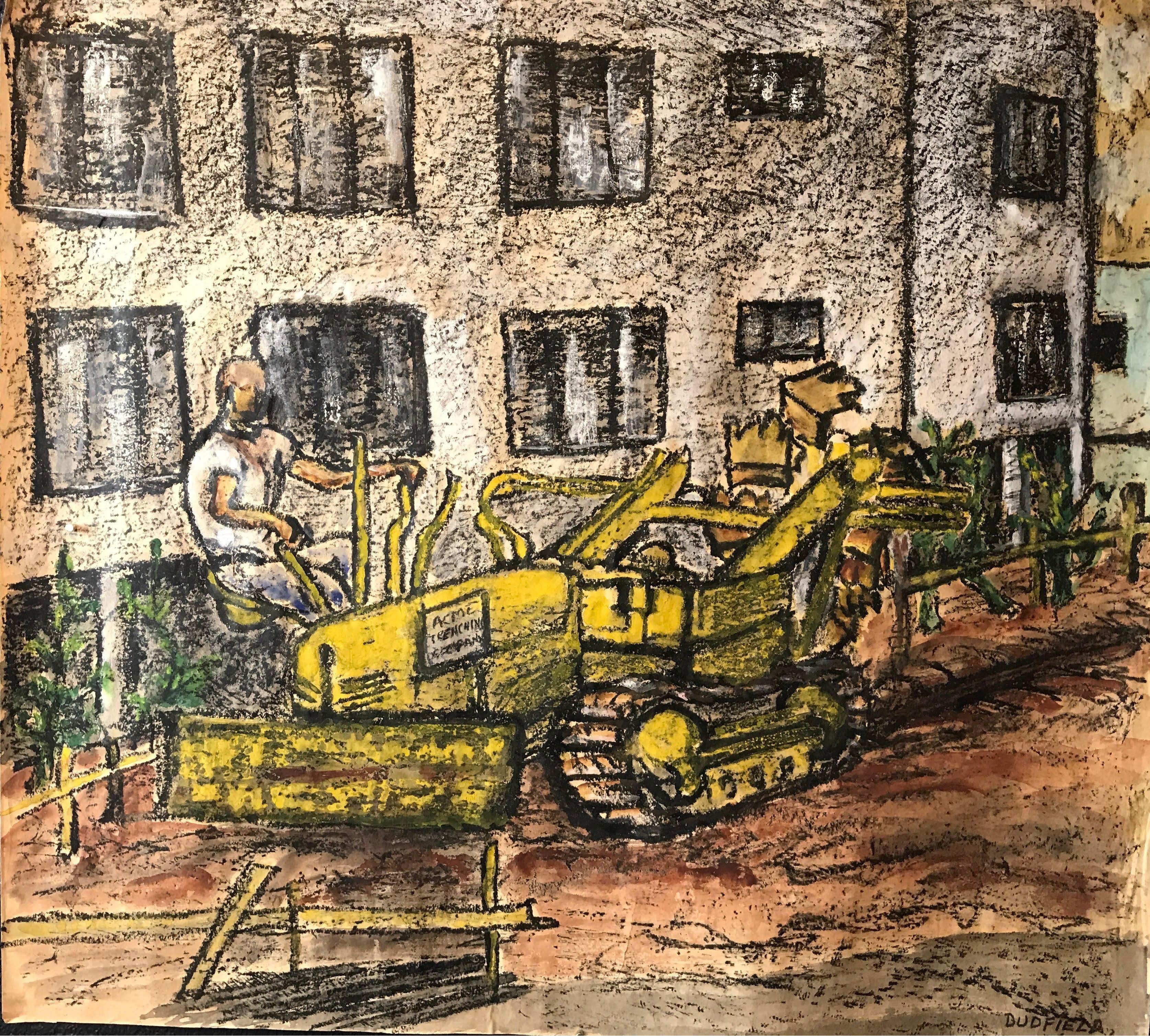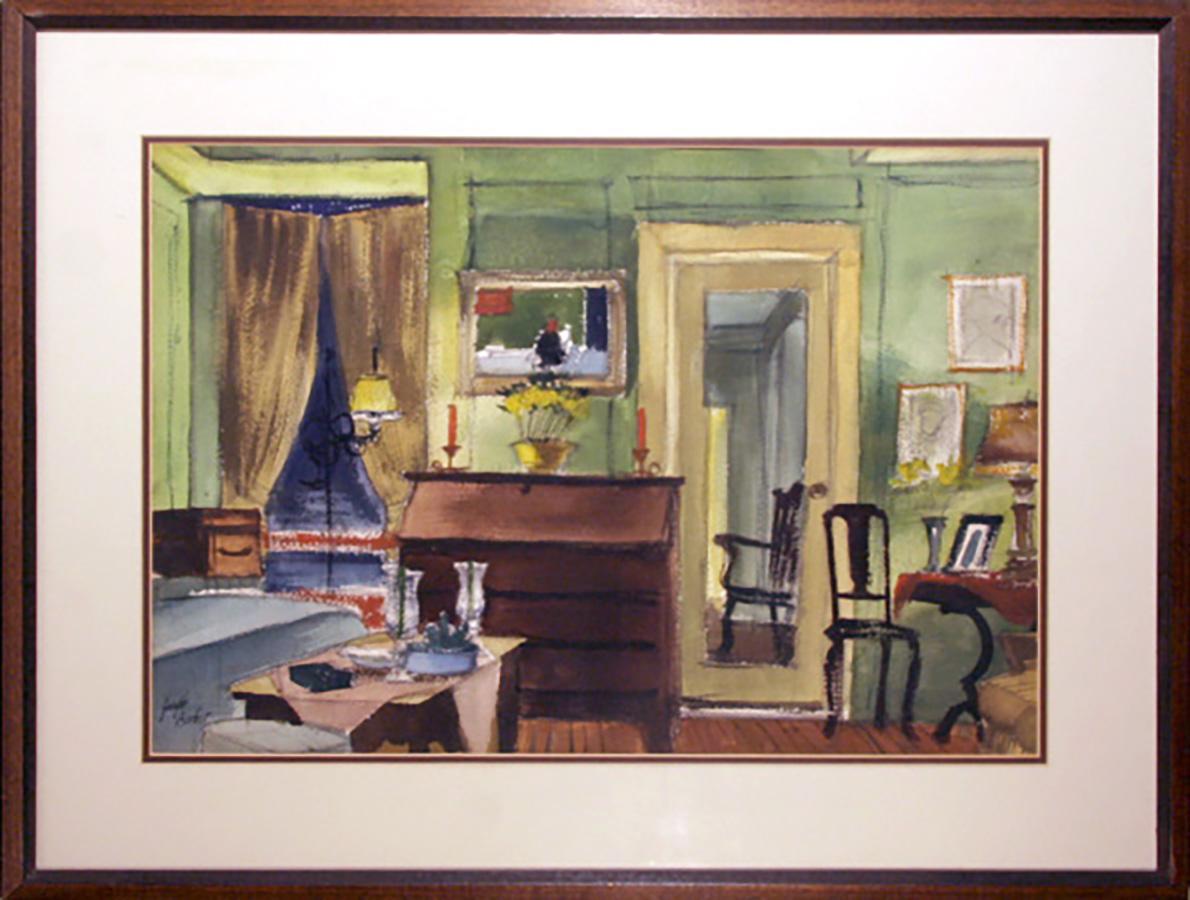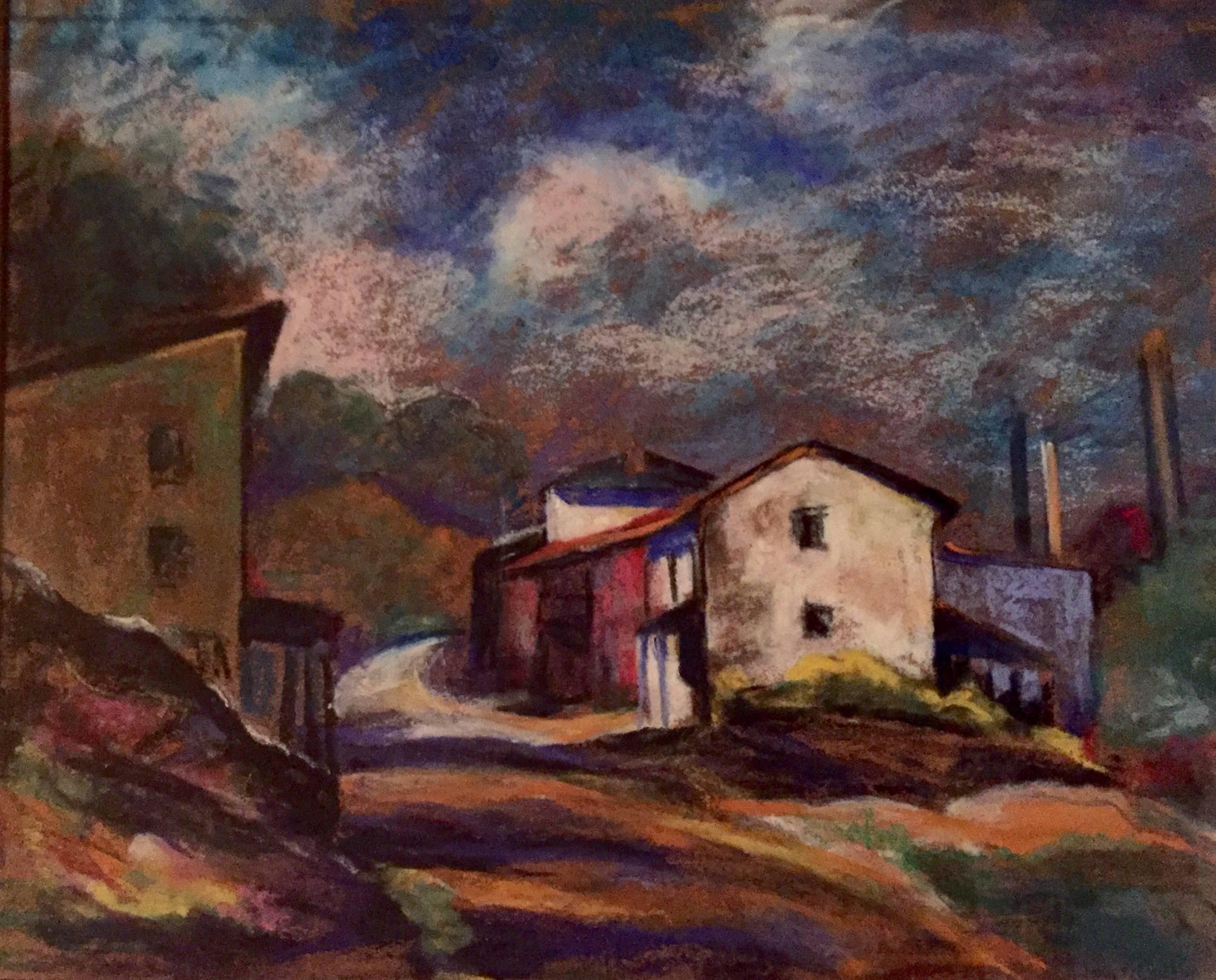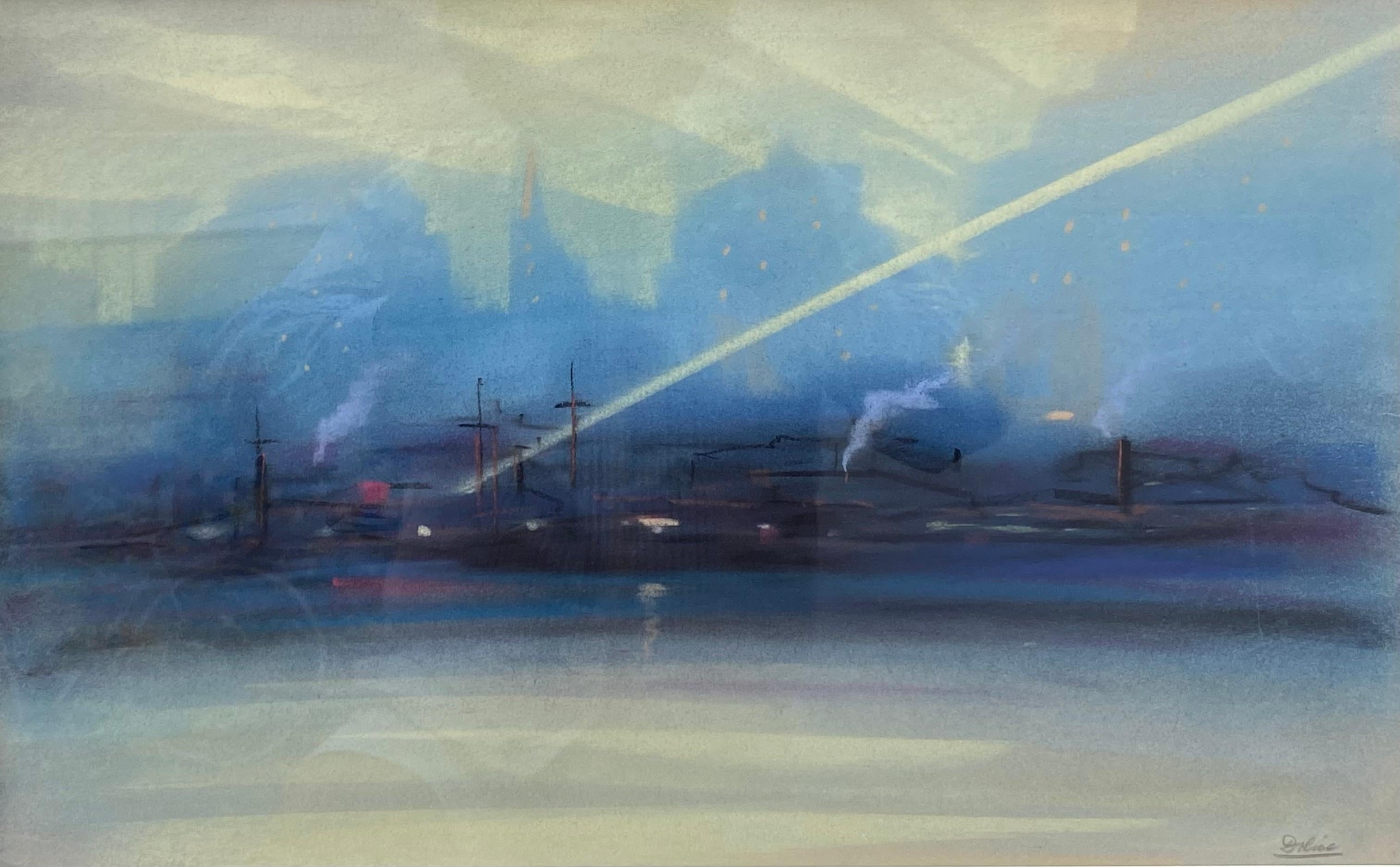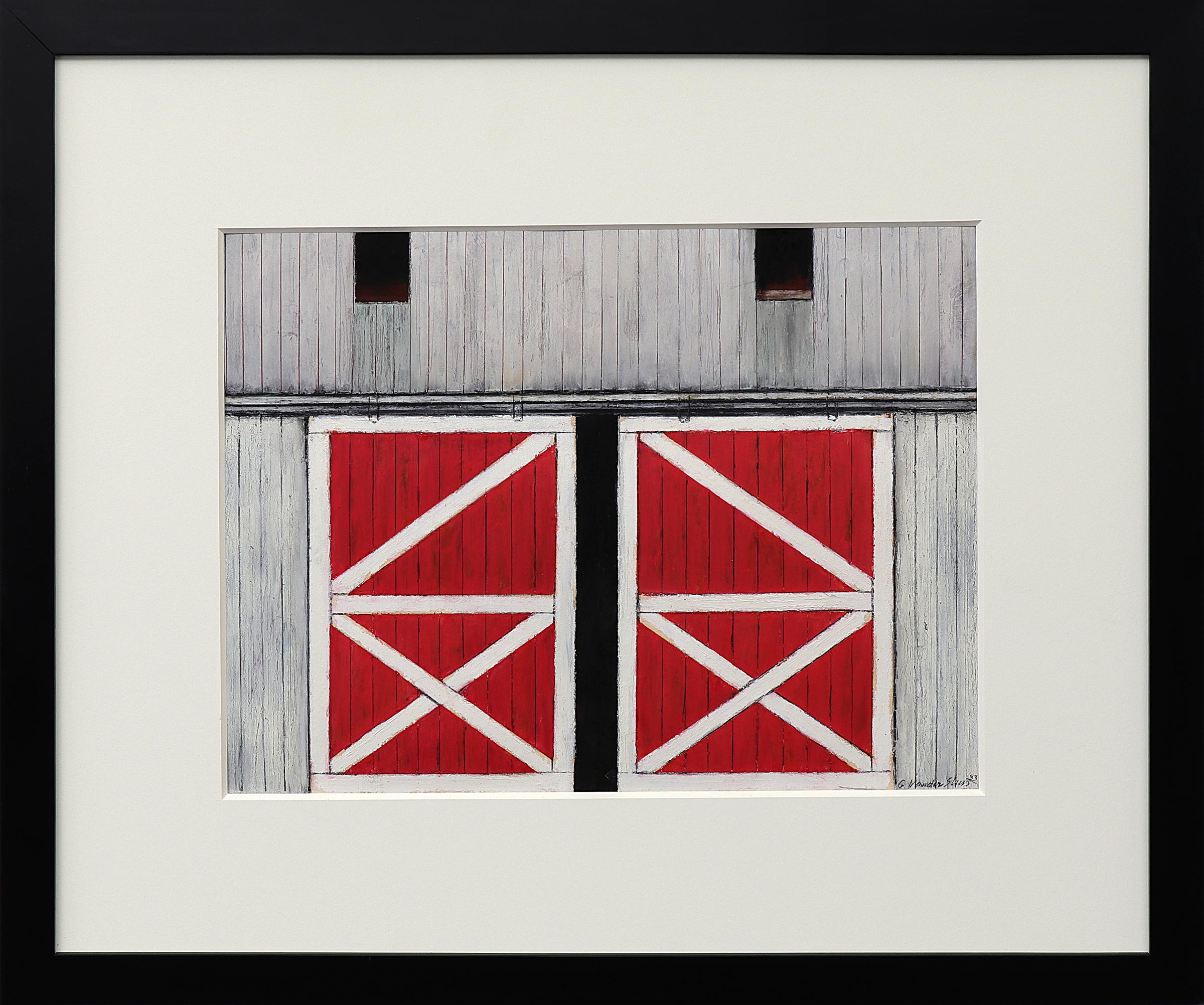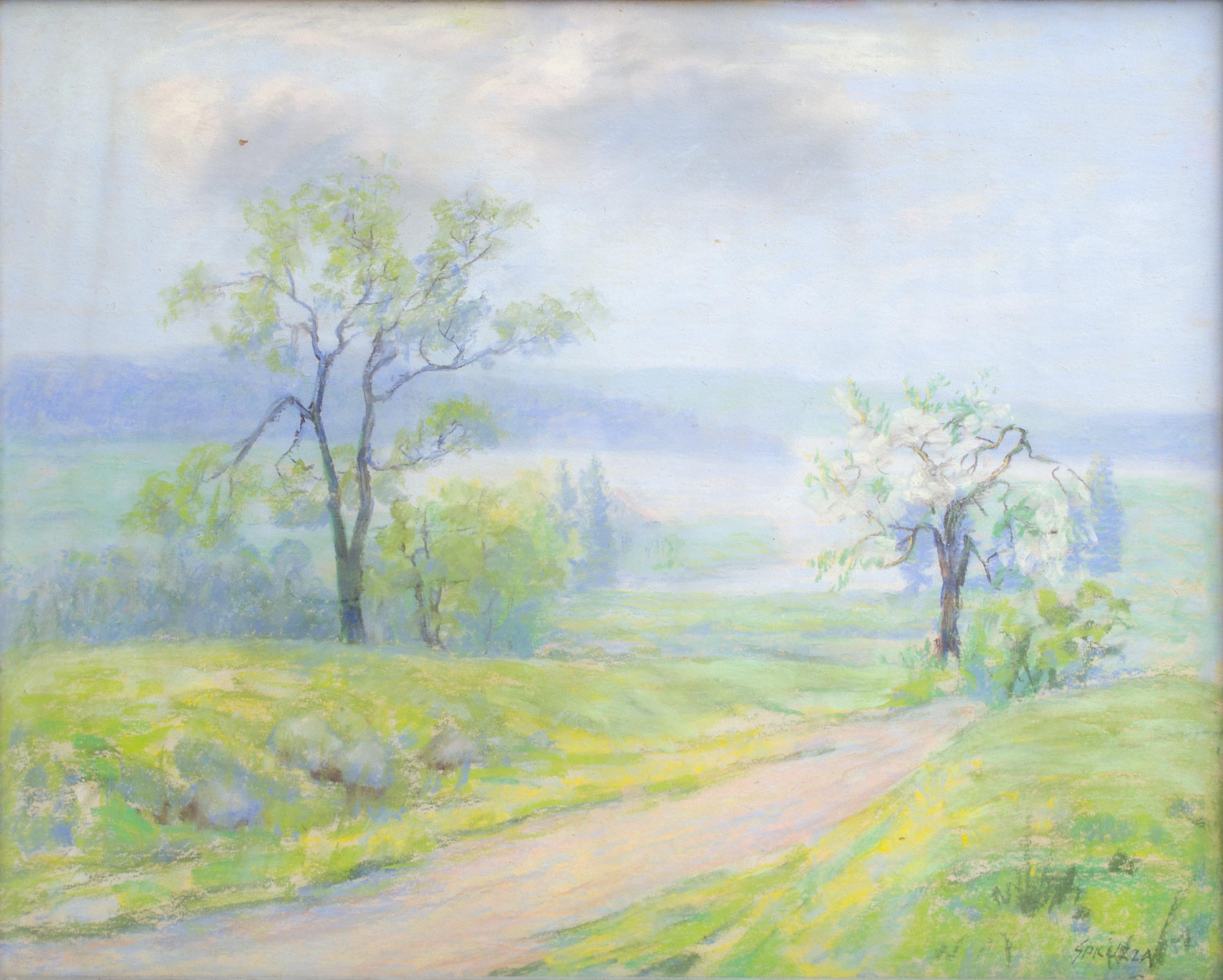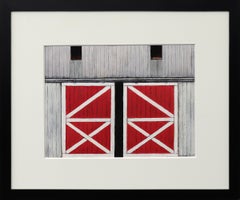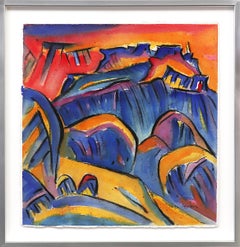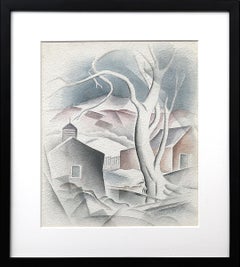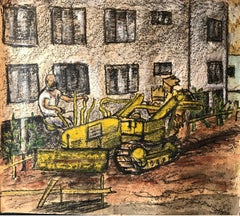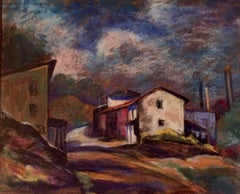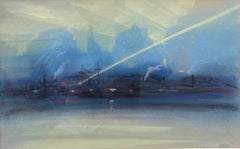Items Similar to Garden of the Gods Nightscape – Original American Modernist Landscape Painting
Video Loading
Want more images or videos?
Request additional images or videos from the seller
1 of 12
Sushe FelixGarden of the Gods Nightscape – Original American Modernist Landscape Painting1987
1987
About the Item
Immerse yourself in the breathtaking beauty of Garden of the Gods with this stunning original pastel drawing by renowned Colorado artist Sushe Felix. Set against a dramatic nighttime sky, this modernist landscape captures the vibrant red rock formations, soft drifting clouds, and a sky filled with twinkling stars, evoking the tranquil yet powerful essence of this iconic natural landmark near Colorado Springs.
Created in 1987, this masterfully executed pastel on paper showcases Felix’s signature use of bold color, delicate gradients, and striking composition to bring the rugged beauty of the Colorado wilderness to life. The artwork is signed by the artist, titled, and dated on the reverse, ensuring its authenticity and collectible value.
Professionally framed with archival materials, this piece is preserved for longevity while the custom frame enhances its vibrant hues and modernist appeal.
Perfect for art collectors, nature enthusiasts, and admirers of Colorado’s dramatic landscapes, this one-of-a-kind pastel drawing offers a rare glimpse into the serene and awe-inspiring nighttime atmosphere of Garden of the Gods.
- Creator:Sushe Felix (American)
- Creation Year:1987
- Dimensions:Height: 14 in (35.56 cm)Width: 18.5 in (46.99 cm)Depth: 0.5 in (1.27 cm)
- Medium:
- Movement & Style:
- Period:
- Framing:Frame IncludedFraming Options Available
- Condition:
- Gallery Location:Denver, CO
- Reference Number:Seller: 270851stDibs: LU27315803492
About the Seller
5.0
Vetted Professional Seller
Every seller passes strict standards for authenticity and reliability
Established in 1979
1stDibs seller since 2013
286 sales on 1stDibs
Typical response time: <1 hour
- ShippingRetrieving quote...Shipping from: Denver, CO
- Return Policy
Authenticity Guarantee
In the unlikely event there’s an issue with an item’s authenticity, contact us within 1 year for a full refund. DetailsMoney-Back Guarantee
If your item is not as described, is damaged in transit, or does not arrive, contact us within 7 days for a full refund. Details24-Hour Cancellation
You have a 24-hour grace period in which to reconsider your purchase, with no questions asked.Vetted Professional Sellers
Our world-class sellers must adhere to strict standards for service and quality, maintaining the integrity of our listings.Price-Match Guarantee
If you find that a seller listed the same item for a lower price elsewhere, we’ll match it.Trusted Global Delivery
Our best-in-class carrier network provides specialized shipping options worldwide, including custom delivery.More From This Seller
View AllAmerican Modernist Oil Stick Drawing: Landscape of Gray Barn Red Sliding Doors
Located in Denver, CO
This stunning oil stick on paper titled "Barn Side with Sliding Doors" by renowned American artist George Vander Sluis (1915-1984) depicts a serene...
Category
1980s American Modern Figurative Paintings
Materials
Paper, Oil Pastel
Hopi Village on First Mesa, Arizona: Red, Blue, Orange Mixed Media Landscape Art
Located in Denver, CO
This striking mixed-media artwork, titled Walpi #9 (Hopi Village on First Mesa, Arizona), is a masterful combination of watercolor, ink, and charcoal on paper by Bert Van Bork...
Category
1990s American Modern Landscape Drawings and Watercolors
Materials
Charcoal, Ink, Watercolor
Second Mesa Hopi Pueblo Arizona Multicolored Southwest Mixed Media Landscape Art
Located in Denver, CO
"Second Mesa (Hopi Pueblo, Arizona)" is a stunning mixed media artwork by Bert Van Bork (1928-2014), created using watercolor, ink, and charcoal on paper...
Category
1980s American Modern Landscape Drawings and Watercolors
Materials
Charcoal, Archival Ink, Watercolor
1930s American Modernist Colorado Winter Landscape Watercolor, Trees, Mountains
Located in Denver, CO
This 1938 watercolor painting by American Modernist artist Turner B. Messick depicts a serene winter landscape, likely set in Colorado. The scene features a bare tree in the foregrou...
Category
1930s American Modern Landscape Paintings
Materials
Watercolor
Georgetown, Colorado, 1938 WPA Era Ink Drawing of Rocky Mountain Landscape
By Charles Ragland Bunnell
Located in Denver, CO
This vintage 1938 ink drawing by Charles Bunnell (1897–1968) captures a stunning scene of a church nestled in the majestic Rocky Mountains of Georgetown, Colorado. Executed in bold black ink on creamy white paper, the piece is signed and dated by the artist in the lower right and titled in the lower left. The image size is 7 ¾ x 5 ¾ inches, and it is framed with archival materials, with outer dimensions measuring 16 ¼ x 14 ½ x 1 ¼ inches.
Condition:
The drawing is in good vintage condition, with no notable flaws. For a detailed condition report, please contact us directly.
Provenance:
This artwork comes from the estate of Charles Ragland Bunnell, ensuring its authenticity.
About Charles Bunnell:
Charles Bunnell was a prominent American artist whose career spanned multiple styles and influences. Born in Kansas City, Missouri, he moved to Colorado Springs around 1915, where he developed a love for art. After serving in World War I, Bunnell studied at the Broadmoor Art Academy (later renamed the Colorado Springs Fine Arts Center), where he met his wife, Laura Palmer...
Category
1930s American Modern Landscape Drawings and Watercolors
Materials
Ink
Vintage Colorado Mountain Landscape, Original Modernist Graphite Drawing, Framed
By Boardman Robinson
Located in Denver, CO
This original graphite on paper drawing by renowned artist Boardman Robinson (1876-1952) captures the dramatic beauty of a Colorado mountain landscape...
Category
20th Century American Modern Landscape Drawings and Watercolors
Materials
Graphite
You May Also Like
1964 San Francisco Construction Site Large Gouache and Pastel Landscape
By Gloria Dudfield
Located in Arp, TX
Gloria Dudfield
Tractor at Work
6-10-64
Gouache and Oil Pastel on Paper
36"x32 1/2" Unframed
Signed and dated lower right in crayon
Very Good Condition - Minor wear consistent with ...
Category
1960s American Modern Mixed Media
Materials
Paper, Oil Pastel, Gouache
Dining Room Interior, Impressionist Pastel Drawing by Joseph Barber
By Joseph Barber
Located in Long Island City, NY
Artist: Joseph Barber, American (1915 - 1998)
Title: Dining Room Interior
Year: circa 1945
Medium: Watercolor and Pastel on Paper, signed l.l.
Size: 15 x 21 inches (38 x 53.5 cm)
Fra...
Category
1950s American Modern Landscape Drawings and Watercolors
Materials
Oil Pastel, Archival Paper
$2,800 Sale Price
20% Off
"The Winding Road"
By John F. Carlson
Located in Southampton, NY
Here for your consideration is a very well executed pastel on paper by John Fabian Carlson. Signed lower right and mostly likely done in the 1930's...
Category
1920s American Modern Landscape Drawings and Watercolors
Materials
Paper, Oil Pastel
$2,240 Sale Price
20% Off
“New York at Night”
By Leon Dolice
Located in Southampton, NY
Very well executed original pastel on archival paper of New York City at night with beacon by the well known American artist, Leon Dolice. Signed lower right. Circa 1930. Condition is excellent. Beautifully gallery framed with stained mahogany wood frame. Under glass. Overall framed measurements are 21 by 30 inches. Birham Wood Galleries, East Hampton, New York provenance. Exhibited artwork. See photo gallery labels verso.
Leon Dolice was born in Vienna, Austria on August 14, 1892, the son of a machinest/welder. He went on to study art in Europe and viewing the works of the Masters. Dolice immigrated to the United States in 1920, finding a retreat in the European Bohemianism of Greenwich Village, he picked the streets of this landmark neighborhood as his first subjects. Concentrating on etching and with the encouragement of new found friends and artists such as George Luks and Herb Roth, he soon ventured out and devoted all his time to chronicling the architecture, back streets, dock scenes and other nostalgia that was fast disappearing from the face of Manhattan, mainly in copperplate etchings. A favorite subject for him was the Third Avenue El near one of his New York City studios on Third Avenue. He won accolades for his work, and although he traveled the East Coast recording landmarks in other cities including Washington DC, Baltimore, Chicago and Philadelphia, he always returned to his new home Manhattan.
A decline in popular favor for etchings led him to put aside his plates in the late 1930s and devote some ten years to pastels, linocuts and painting. His subject matter was almost exclusively New York City street scenes, but figurative works, country scenes, and even experiments with Abstract Expressionism at the height of its new found favor in the 1940s punctuated his career.
In 1953, after learning of the forthcoming demise of the Third Avenue El, in the shadow of which he had maintained his studio for over a decade, he once again took to his plates and press and created a final series of Third Avenue and or other New York City landmarks that were then threatened with extinction. His work brings to light aspects of nostalgic New York that survives today only in small part, whether in architecture or in spirit.
Dolice's works are in a number of notable museums and private collections, including the Museum of the City of New York; The New York Public Library Print Collection; The New York Historical Society; Georgetown University Lauinger Library; The Print Club of Philadelphia and others. In the past few years, his work has been exhibited at Hofstra Museum, Long Island, NY; with the Montauk...
Category
1930s American Modern Landscape Drawings and Watercolors
Materials
Oil Pastel, Archival Paper
Beautiful large impressionist pastel by Francesco Spicuzza
By Francesco Spicuzza
Located in New York, NY
Francesco Spicuzza (American, 1883-1962)
Untitled Landscape, 20th century
Pastel on paper
Sight size: 24 x 30 in.
Framed: 26 1/4 x 32 3/8 in.
Signed lower right: Spicuzza
Italian-born Francesco Spicuzza was primarily a Wisconsin painter who did portraits, still-lives and local landscapes. He spent the first part of his life in near-poverty to become a painter. An eternal optimist, in 1917, the artist reported: "I am happy and my only ambition now is to paint better and better until I shall have reached the measure of the best of which I am capable." (Spicuzza, 1917, p. 22). His predilection for beach scenes germinated early: reportedly, the five-year-old boy first drew the outlines of his father's fishing boat in the sand on the seashore near their home in Sicily. After setting himself up as a fruit peddler in Milwaukee, Spicuzza's father sent for his family when Francesco was eight years old. For the following six years the boy was unable to attend school because of his job in his father's fruit and vegetable business. The poor lad suffered a caved-in shoulder from carrying a heavy wooden crate.
The young Spicuzza was aided by moral and financial support from a sympathetic Milwaukee businessman named John Cramer, publisher and editor of the Evening Wisconsin, who raised Spicuzza's salary as a newspaper assembler so that he could attend school. In 1899 or 1900, Spicuzza began studying drawing and anatomy under Robert Schade (1861-1912), a painter of panoramas who had been trained in Munich under Carl Theodor von Piloty. Spicuzza was also taught by Alexander Mueller (1872-1935), a product of the Weimar and Munich academies. Mueller realized Spicuzza was a colorist and encouraged that orientation (Madle, 1961). Spicuzza found it beneficial to accept an apprenticeship in a lithographic studio for $8 a week, which demanded most of his time. During the St. Louis Universal Exposition in 1904, still a struggling student, Spicuzza attended the fair, thanks to Cramer. It was not long before Spicuzza received a twenty-five dollar portrait commission, and this inaugural success led to new commissions and allowed him to continue as a painter.
The earliest influences in his work appear to be from Edward H. Potthast and Maurice Prendergast, though Spicuzza never mentioned either artist. Already in August 1910, Spicuzza was described in a newspaper as "one of the most talented of Milwaukee's rising workers." He undoubtedly received lasting inspiration from his one summer study period in 1911 with John F. Carlson at the Art Students League's Summer School in Woodstock, New York. Certainly Spicuzza would have picked up spontaneity in handling the brush from Carlson. Although he executed numerous still-lives and an occasional religious work, Spicuzza is best known for his Milwaukee beach scenes populated with frolicking bathers in multi-colored attire, not unlike the images of Potthast, who used a similar technique. Many of these are small, preparatory works on canvas board executed between 1910 and 1915. Frequently with even greater animation than Potthast, Spicuzza produced moving images of youthful energy and uninhibited child's play. These beach genre scenes reflect the attitude of American impressionists who depicted the more pleasant side of life.
Spicuzza manipulated a successful balance of rich pigment applied in varying degrees of impasto texture with subtle nuances of hue. Working all'aperto, he sought "the soft enticing shades of yellow, blue, green, pink and lavender . . . to get the effects of bright glistening summer air." (L.E.S., n.d.). As a painter whose color not only derived from direct observation but also from a personal theory of color symbolism, Spicuzza traded the linear approach of lithography for dynamic patches of brilliant color. Like Prendergast, he would often tilt the angle of the picture plane to bring the viewer's position above the scene.
Spicuzza was unable to enter the 1913 Armory Show or the Panama-Pacific International Exposition two years later but he did submit work to the annual exhibitions of the Pennsylvania Academy of the Fine Arts and those of the Art Institute of Chicago. His first important award was the bronze medal presented by the St. Paul Institute in 1913, which was followed by the silver medal two years later. Before long, Spicuzza had acquired a greater sense of security in his profession and was described by a writer in International Studio (April 1917) as "an independent artist with an assured future. His pastels and water-colours are poetic and joyous bits of nature with a genuine out-of-door feeling." In 1918, his Spirit of Youth, exhibited at the National Academy of Design, sold for $112.50. Four years later, the artist achieved his greatest local recognition by winning the gold medal from the Milwaukee Art Institute.
Spicuzza spent a great deal of time painting en plein air and by 1925 he began summering at Big Cedar Lake, near West Bend, Wisconsin to gather his subject matter. Easter Morning (1926) owes something to the Symbolist movement, with its figure of Christ appearing over a seascape. During the difficult era of the Depression, patrons came to Spicuzza's aid and during the 40s, he taught housewives, businessmen and students at the Milwaukee Art Institute, the Milwaukee Art Center, and in his private studio. In the following decade, although his kind of art was no longer popular in the "make-it-or-break-it" New York gallery world, Spicuzza enjoyed regular patronage and sales. His beach scenes became more static and he would experiment with modernist techniques. Spicuzza died at the age of seventy-eight.
Sources:
L.E.S., "Do Colors Change a Person's disposition? Experiments of a Milwaukee Artist...
Category
20th Century American Modern Landscape Drawings and Watercolors
Materials
Paper, Pastel
Untitled
Located in Bournemouth, Dorset
Sally Barclay (1911-2000) was a New Jersey Artist known for her painting and activities as an art teacher.
Signed front and back.
Category
1950s American Modern Landscape Drawings and Watercolors
Materials
Crayon
$494 Sale Price
20% Off
Recently Viewed
View AllMore Ways To Browse
Colorado Artists
Modernist Landscape Painting
Felix Vintage
Spring Landscape Watercolor
Garden Oil Pastel
Modernist Pastel
American Wilderness
Watercolor Landscapes Colorado
Pastel Colorado
Garden Of The Gods
Nighttime Oil Painting
Painting Sale
Painted Wood Sculpture
Red Landscapes Painting
Vintage Again And Again
California Artist Oil Painting
Paintings With Hearts
20th Century Limited
